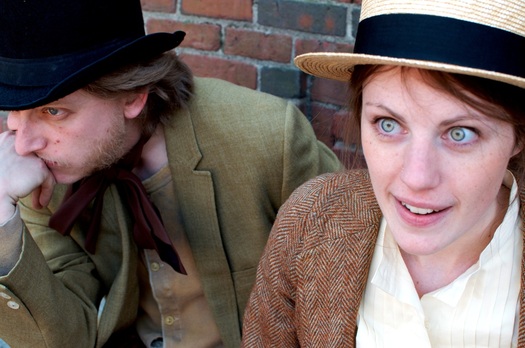
Trog (Cameron Beaty Gosselin) and Clay (Louise Hamill) dream of their elusive next meal. Photo by Sunny M. Rissland
Trog and Clay: An Imagined History of the Electric Chair by Michael Vukadinovich, Fresh Ink Theatre, The Factory Theatre, 4/27/12-5/12/12, http://www.freshinktheatre.com/on-stage.html.
Reviewed by Gillian Daniels
(Boston, MA) Fresh Ink Theatre Company’s Trog and Clay crackles with manic energy from its first moments. Actors throw themselves into their roles with performances that range from amusingly campy to blindly sincere. Michael Vukadinovich’s historical fiction is a dark one with the inspiration it takes from the first use of the electric chair, but the story is joyful and unrepentantly funny.
Trog (Cameron Beaty Gosselin) and Clay (Louise Hamill) are philosophizing best friends and bums on the look out for dogs to catch and sell to Thomas Edison (Terrence P. Haddad) for a quick buck. Hamill’s sweetly naïve Clay is horrified to learn Edison’s publicly electrocuting the dogs to demonstrate the “dangers” of alternating current.
Edison, here, is a vamping mad scientist and merciless business mogul. He now looks to further discredit alternating current by using the electric chair of his rival, George Westinghouse (Mikey DiLoreto), in the death sentence of William Kemmler (Chris Larson). The presence of Westinghouse’s actress wife, Marguerite (Renée Rossi Donlon), revises the events that surround the historical rivalry into a tragicomic love polygon. Donlan is self-interested and hilarious. Unfortunately, while memorable, Mrs. Westinghouse feels more like an archetypal drama queen than a flesh-and-blood person.
Haddad, DiLoreto, and Donlon amp up their characters to melodramatic and comical heights, but the more subdued performances steal the show. Larson’s Kemmler is fascinating as a sad, uneducated romantic and Louise Hamill is wonderful as a cross-dressing “sexual deviant.” She and Gosselin aren’t innocent in their own right but their goals and conflicts remain straightforward. Kemmler, Trog, and Clay are all just caught up in the mechanizations of a much broader plot. History won’t remember much of the everyday folk, the play suggests, but they were there none-the-less.
Trog and Clay: An Imagined History of the Electric Chair doesn’t always balance its disparate elements evenly. Comic scenes and characters sometimes mesh in an awkward way with real-life tragedy. William Kemmler, a convicted murderer, really was electrocuted in the midst of the most memorable rivalry of the late 19th century. The absurdity and nerve of the show, however, make it a shining experience. An audience as willing to embrace the ride as the titular Trog and Clay should leave enormously satisfied.
